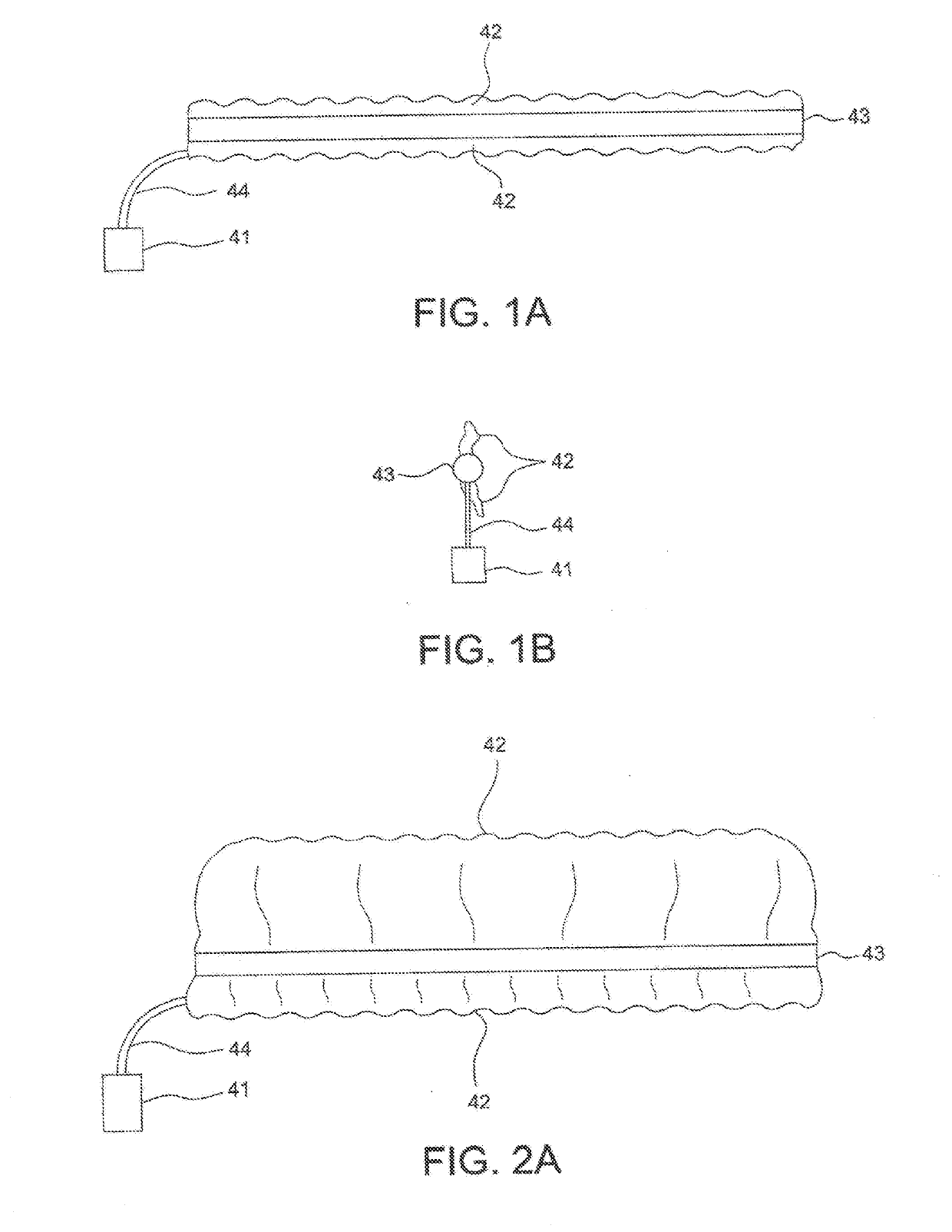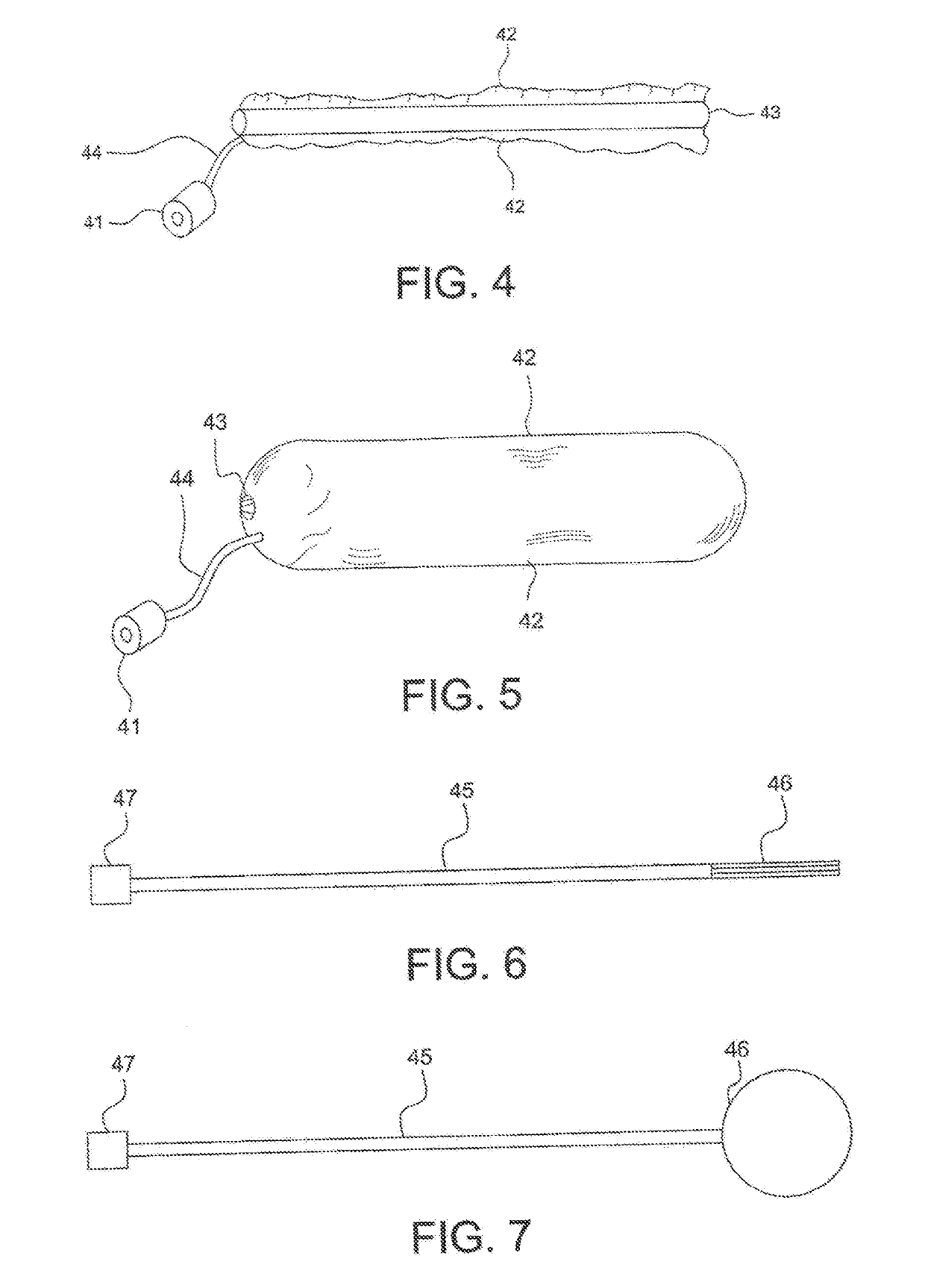Epistaxis (
nosebleed) remains a common problem.
Correct gauze positioning often presents a daunting challenge for urgent care or
emergency department physicians who perform this procedure infrequently.
As a practical matter, placement by an inexperienced provider prolongs the time required to control epistaxis which increases the already significant patient discomfort associated with any packing and, likely, impairs the actual success of treatment.
Further, failure of (or unfamiliarity with) this method then requires consultation with an otolaryngologist (ear,
nose, and
throat specialist), which incurs additional cost and
treatment time.
The plethora of designs testifies to the fact that an optimal solution remains elusive.
Otherwise, it will simply dislodge backward and downward, offering no benefit yet incurring risk of falling into the laryngeal area and causing
airway obstruction.
Understandably, this is technically difficult and predictably uncomfortable.
Each of these has problems and limitations with regard to effectiveness and ease of use that shall be discussed in the review of prior art.
It becomes very slippery after being wetted to facilitate
insertion.
While the
sponge and balloon packs offer fast and relatively easy means to pack an anterior nosebleed, epistaxis from the back of the nose has remained the far greater challenge for the non-otolaryngologist.
This requires overcoming several problems:Difficulty of placement of a pack slightly less than the size of a ping-pong ball behind the back of the nose / nasopharynx.Necessity of passing strings or other tensile material out the
nostril to maintain forward pull on the pack as well as to bring a separate retrieval string out through the mouth (taped to the
cheek) for effective pack removal.Infrequent practice understandably causes unfamiliarity with this technique.
This may cause unsatisfactory results and subsequent need for consultation with an ear, nose, and
throat specialist.
Associated with this are increased
treatment time in the
care facility, additional pain / trauma with repeated packing attempts, plus the added cost of the otolaryngology consultation.
Finally, these treatment settings usually lack many of the necessary supplies necessary for traditional anterior-posterior packing.
None are presently in production, perhaps due to their impractical nature.
These seek to reach into recesses of the
nasal cavity (such as underneath
turbinates) to better apply pressure although greatly increase complexity of manufacture.
Disadvantages of Prior Art Nasal Packs
Disadvantages of Rigid
Sponge Packing
Despite the simplicity of design and general ease of use, these devices have a number of drawbacks in clinical use:They are rigid, hard, and non-yielding.
Insertion into nasal cavities of varying shape can result in significant pain as well as abrasions and
tears of the nasal mucosa that may result in additional hemorrhage.On occasion, a
nasal septal deviation or other anatomic variant can completely prevent
insertion of one of these rigid devices.Some sponges incorporate longitudinal tubes purportedly to allow
respiration.
Unfortunately, they greatly increase the width of the device and cause additional difficulty, trauma, and pain with
insertion.
However, the effective
airflow through a 3-4 mm tube seems dubious, particularly when it becomes occluded with
mucus and blood.These
sponge devices absorb blood thereby offer culture media for
bacteria.
Toxic shock syndrome has occurred in this type of device in a similar manner to vaginal tampons.The surfaces of these
sponge devices often adhere to the mucosa and, with removal, can disrupt the healing surface and cause re-bleeding.
Disadvantages of Anterior
Balloon Packing
Limitations with their use include:Provide treatment of anterior nosebleeds only.Transition to anterior-posterior packing results in extra cost when the anterior pack is used, fails, and is discarded.Many incorporate elastic balloons that concentrate pressure at their center, which usually corresponds to the middle of the nasal cavity and away from anterior sites where bleeding predominates.
This balloon shape may require higher inflation pressure, exacerbating pain.None exists as part of a
system that includes a simple method of adding posterior packing to the already in-place anterior pack.
In addition to drawbacks described more fully below, they share some common disadvantages:Typically, they are used when an anterior pack has failed and been discarded.
This waste increases treatment cost.These are all one-size-fits-all devices and may not fit varying anatomic dimensions of different patients.
The two balloons cannot be positioned and tensioned separately.They lack means to keep the pack in a specific anterior-posterior orientation to the nasal cavity.
They can slip out of position which compromises their effectiveness.Certain of the designs could be used for anterior-only packing and then have the posterior balloon inflated if needed.
However, that would increase cost by using a more complicated and expensive pack for every nosebleed.Particular problems associated with the various designs are described below.
Some issues arise with clinical use:Both incorporate a fairly rigid shaft with an interior lumen preventing passage through narrow nasal cavities while offering minimal
airflow.They have elastic balloons with the attendant problems noted above.These can migrate posteriorly.
The Y-shaped external end can apply pressure to the
nostril margins resulting in tissue loss and permanent
notching defects.
Gottschalk (U.S. Pat. No. 3,570,494)This also has similar disadvantages to the Bivona® and Epistat® devices as described below although it lacks the Y-shaped inflation portion and its associated problems.The forward balloon actually inflates in the nasal opening.
This increases the potential for discomfort as well as for damage to the functionally and cosmetically important
nostril.
Pidgeon (U.S. Pat. No. 3,766,928)The pair of small balloons only provide
occlusion of the front and rear of the nasal cavity.They lack means to apply hemostatic pressure or potential application of a
hemostatic agent throughout the rest of the nasal cavityThe pack appears to be particularly susceptible to migration out of position.
Drawbacks include:Potential difficulty in passing the rigid sponge pack and larger
diameter shaft through some noses.Additional sponge-related problems such as potential for toxic shock and adherence to
mucus membrane and chance for re-starting hemorrhagePotential for rearward dislodgement of the device.
Drawbacks of the designs include:The preferred embodiment may incorporate a larger
diameter core (part #2) for
respiration, passage of a nasogastric tube, etc. that may make placement through narrow nasal cavities problematic.The posterior
catheter lacks means to secure it in positionThis is not an integrated
system for providing combination anterior / posterior packing to address situations when anterior packing alone fails.
Problems for these include:Complexity of manufacture to include the numerous protrusions in comparison to a more basic balloonSeveral of the designs appear difficult to place in the noseSome have larger
diameter tubes that may make insertion difficult.
Several drawbacks may be identified with this design, however:The device length and shape may result in contact with
adenoid area and / or
soft palate which could cause
irritation, pain, and bleeding.The hollow
respiration tube would likely experience obstruction with secretions as mentioned above.
These functions include
irrigation of the nose and sinuses, dilation of stenotic areas, dilating the
eustachian tube.Many appear of questionable
patient comfort as well as functionality with regard to placing and maintaining position during use.None provides good nasal mucosal compression for epistaxis.
Rapid Rhino® 900This device shares limitations noted above with the Epistat® and Bivona® packs though lacks the Y-shaped portion that can cause tissue damageAlthough the
carboxymethyl cellulose makes the pack slippery to improve ease of insertion, this same quality could make posterior migration more likely.
 Login to View More
Login to View More  Login to View More
Login to View More 


